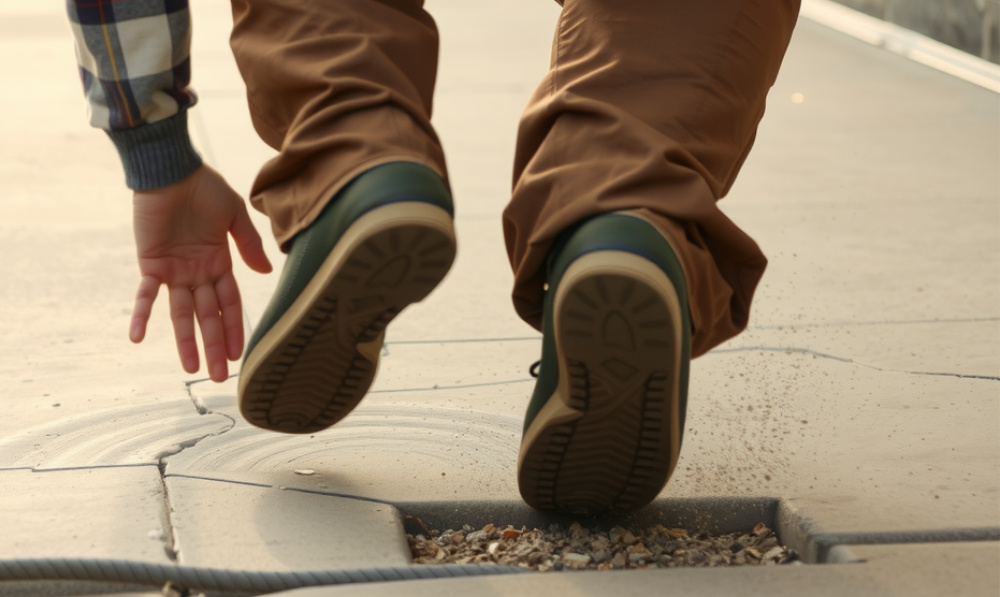
Nebraska isn’t exactly the most walkable state. But in the most walkable cities—Omaha, Lincoln, and parts of Bellevue—residents and visitors encounter a surprising number of cracked sidewalks, abrupt elevation changes, crumbling curb ramps, and dangerous intersections. The problem is often less about wear and tear and more about neglect—issues that go unresolved until someone gets hurt.
Slip and fall accidents on sidewalks aren’t always minor mishaps. Sometimes, they lead to serious injuries, months of recovery, and stacks of medical bills. And when the sidewalk that caused the accident is on government property, the injured person often wonders what rights they have.
So, can you sue a government entity for a sidewalk fall in Nebraska? The short answer is yes, but it’s not simple. Suing a city, county, or state government involves navigating special rules, strict deadlines, and unique legal challenges. At Hauptman, O’Brien, Wolf & Lathrop, LLC, we help Nebraskans hold government entities accountable under the law.
Injuries Commonly Sustained After Sidewalk Slips or Trips
Sidewalk fall accidents can cause more damage than most expect. Whether the injured party is young, elderly, or somewhere in between, even a single misstep can lead to lasting physical consequences.
Some of the most common injuries resulting from a fall on public sidewalks include:
- Broken bones, especially wrists, ankles, and hips
- Concussions or traumatic brain injuries (TBIs)
- Lacerations and contusions
- Spinal injuries and herniated discs
- Soft tissue injuries like torn ligaments and sprains
The severity of these injuries often depends on how the person landed, whether they were carrying something, and the condition of the sidewalk. The injuries sustained may demand emergency treatment, surgery, rehabilitation, or long-term care, often accompanied by medical bills that can quickly become overwhelming.
A personal injury claim can help victims recover compensation for those costs, but who is responsible depends on where the fall happened and why.
Dangerous Premises: What Makes a Sidewalk Legally Hazardous?
Whether you’re dealing with private property owners or government entities, the legal concept of premises liability plays a central role in slip and fall cases. This area of law is rooted in the notion that those responsible for a property must take reasonable steps to keep it safe.
Uneven pavement, poor lighting, tree root upheaval, or icy conditions can all lead to a dangerous condition that puts pedestrians at risk. And when someone is injured due to a property owner’s failure to act with ordinary care, they may be held liable for the injuries caused.
But the rules shift significantly depending on whether the sidewalk is on public or private property.
Private Property Owner Responsibilities
Private property owners in Nebraska—residential homeowners, landlords, commercial business owners—are generally responsible for the sidewalks directly abutting their property. If the sidewalk is damaged or dangerous, and someone falls, these owners could be found at fault under state premises liability laws.
For instance, a slip and fall accident caused by ice accumulation that a homeowner didn’t clear in a timely fashion could lead to a successful personal injury claim. Constructive notice—meaning the property owner should have known about the hazard—is often enough to establish fault in these cases.
But even when a private property owner isn’t the one who laid the concrete, they may still be liable if local ordinances place the burden of sidewalk maintenance or snow removal on them.
Sidewalk Responsibilities: When the Government Owns the Property
When a sidewalk is under the control of a local government, such as the City of Omaha or the State of Nebraska, the legal responsibility for maintaining that sidewalk shifts to that entity.
However, suing a government entity for a sidewalk fall is much more complex than suing a private property owner. Sovereign immunity, a doctrine dating back centuries, protects government bodies from lawsuits in many situations. Fortunately, Nebraska’s Political Subdivisions Tort Claims Act (PSTCA) provides a limited waiver of this immunity, allowing certain claims to proceed—if they meet very specific criteria.
Claims involving public property, such as sidewalks, are possible under PSTCA, but claimants must tread carefully. There are different rules, notice requirements, and shorter filing windows that must be followed precisely. Miss one, and your case could be dismissed outright.
Proving the Municipality’s Liability
Just because a fall occurred on a public sidewalk doesn’t automatically mean the government is legally responsible. Slip and fall claims involving municipalities require the injured party to prove four key elements:
- Duty of Care: Cities like Omaha have a legal obligation to maintain public sidewalks in a reasonably safe condition for pedestrians. This includes fixing hazardous defects, like sunken slabs, and clearing obvious obstructions. For instance, suppose a section of sidewalk near a city park has sunken two inches due to soil erosion beneath it—a common occurrence with freeze-thaw cycles in Nebraska. The city’s duty of care includes monitoring such conditions and repairing them in a timely manner.
- Breach of Duty: Now, imagine that residents have reported the sunken sidewalk slab to the city multiple times over the course of several months. If the city fails to inspect, mark, or repair the area despite receiving those complaints, it may be found to have breached its duty. Ignoring prior reports—or simply taking no reasonable action—can be powerful evidence that the city fell short of its legal responsibility.
- Causation: Let’s say someone walking through that park tripped on the very spot residents had complained about. They fall, hit their head on the pavement, and fracture their wrist while trying to break the fall. Here, the dangerous condition—the sunken concrete—was the direct cause of the accident and injuries sustained. Establishing this link between the breach and the injury is vital in any fall claim.
- Damages: Finally, the injured person must demonstrate measurable harm. In this example, the individual incurred medical bills for the emergency room visit, imaging, and physical therapy. They also missed several weeks of work, resulting in lost wages. These tangible, documented losses help quantify the damages and strengthen the personal injury claim.
What Evidence Do You Need?
Gathering strong, compelling evidence is essential in any fall case—but even more so when a government entity is involved.
Essential evidence may include:
- Photographs of the hazard (uneven surfaces, cracks, icy spots, etc.)
- Witness testimony from people who saw the fall or can attest to the sidewalk’s condition
- Medical records showing the extent of injuries and treatment required
- Maintenance records or public complaints showing the city had actual notice of the issue
- Weather reports that support your version of events (especially for winter-related falls)
In some cases, surveillance footage from nearby homes or businesses may also be useful.
How to Preserve Evidence in Case of a Sidewalk Slip or Trip and Fall Injury
Timing is everything. Many public sidewalks are repaired quickly after an accident, sometimes within days, especially if a government entity fears liability. If you don’t act fast, critical evidence could disappear.
Here are some practical steps to preserve your sidewalk slip and fall claim:
- Take detailed photos and videos of the accident scene right away
- Write down everything you remember, including the time, weather, and circumstances surrounding the fall
- Get the names and contact info of any witnesses
- Seek prompt medical attention—both for your health and your claim
- Report the fall to the relevant city or agency
- Contact a law firm with experience in premises liability and municipal claims
The sooner you consult with an attorney, the better your chances of building a solid injury claim and meeting critical deadlines.
Filing a Claim for a Sidewalk Slip and Fall in Nebraska
Filing a personal injury claim against a Nebraska government entity requires strict adherence to notice deadlines. Under the PSTCA, you must file a formal claim within one year of the accident. If the claim is denied or ignored, you then have two years from the date of the accident to file a lawsuit.
This claim must be submitted to the correct governmental body—in writing—and should include all necessary facts: when and where the accident happened, what the dangerous condition was, what injuries were sustained, and what damages you’re seeking.
Failing to meet these technical requirements can cause your entire claim to be dismissed before it ever reaches a courtroom.
How Can a Personal Injury Attorney Help?
Slip and fall cases are never straightforward, but fall claims involving public property are in a league of their own. There are unique legal hurdles, administrative hoops, and procedural traps at every turn.
A personal injury attorney with experience in sidewalk accident claims can:
- Identify who is legally responsible—property managers, city officials, or contractors
- Investigate the contributing factors to your fall
- Compile the documentation needed to prove liability and damages
- Navigate notice deadlines and paperwork
- Negotiate with the insurance company on your behalf
- Take your case to court if necessary
At Hauptman, O’Brien, Wolf & Lathrop, LLC, we’ve helped countless Nebraskans secure fair compensation for injuries caused by someone else’s negligence, including government negligence. From lost wages and medical bills to pain and suffering, we fight for every dollar our clients are owed.
Contact Our Slip-and-Fall Lawyers Today for a Free Consultation
If you’ve been hurt in a sidewalk fall on government property, don’t wait. Your time to act is limited, and the rules surrounding these cases are complex and unforgiving.
Our attorneys at Hauptman, O’Brien, Wolf & Lathrop, LLC have deep experience handling slip and fall cases against both private property owners and government entities. We understand Nebraska’s laws, the nuances of the PSTCA, and how to gather the evidence needed to build a strong case. More importantly, we understand what you’re going through and are ready to help.
If you slipped, fell, and were injured due to someone else’s neglect, you deserve an advocate. You deserve justice and compensation for your injuries. You deserve a law firm that’s been serving Omaha—and all of Nebraska—for decades. Call us today at (402) 241-5020, or contact us online for a free consultation.


Had a great experience with Hauptman, O’Brien. Beyond the friendly, helpful staff, our claim was handled quickly!